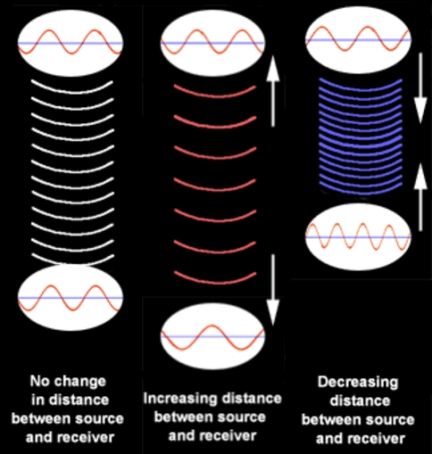Prior to 1800 the Doppler Effect was unknown because there weren’t speeding railroad trains or motorized fire trucks with blaring sirens, so the phenomenon was outside of human experience.
The first person to take note of the Doppler Effect and after whom it was named was an Austrian, Christian Doppler. He had poor health and died young but nevertheless wrote over 50 articles on mathematics and astronomy. In 1842 he published a book titled On the Colored Light of the Binary Stars and Some Other Stars of the Heavens. There he stated that the observed frequency of a wave depends on the relative speed of the source and the observer. This principle applies equally to the pitch of sound propagated through air and to the observed color of visible light, or for that matter to any other type of energy that is propagated as waves.
If the source and observer are moving apart, the frequency will be lower than if they are stationary. For visible light, this is known as red shift. If source and observer are moving toward one another, the frequency will be higher. This is known as blue shift, which is less frequent since the universe is expanding. If, from the perspective of another observer, the first observer is moving away from the source and the source is moving toward the first observer at a faster speed (catching up) the frequency will be blue shifted since it is strictly the relative speed that counts.
If the relative speed is changing, the frequency will change like a musician’s glissando.
The Doppler Effect is equally applicable for waves that propagate through a medium such as sound or water, or for waves that do not require a medium for propagation such as light (or other electromagnetic energy) moving through a vacuum.
The Doppler Effect has been used in astronomy to ascertain the speed that stars and galaxies are approaching or receding from us. The phenomenon is used to detect binaries, to measure the speed of rotation of galaxies and to find exoplanets.
Bright and dark lines in spectra of stars serve as benchmarks. If they are uniformly displaced in a given spectrum, that indicates that the source is either approaching or receding from an observer on earth.
Edwin Hubble, who had previously shown from observation of Cepheid variables that many galaxies lay far outside our Milky Way, in 1929 made a study of red shifts. He found that greater red shifting correlated with greater distance of celestial objects. This implied that the universe is expanding rapidly. Subsequent researchers came to the astonishing conclusion, now generally accepted, that all matter was originally concentrated in a single infinitesimally small point that exploded 13.82 billion years ago in an event termed the Big Bang.
Doppler effects play a role in telecommunications and computations of signal path loss and fading. Fading refers to the attenuation of a signal unpredictably at the receiver, causing transmission problems. The Doppler shift effect can contribute to fading due to multipath propagation.
In multipath propagation, the signal reaches the receiver via multiple paths. When there are multiple signals at the same frequency, there is a potential for destructive interference because of phase-shifted signals arriving from different directions. The situation gets interesting when multipath signals bounce off objects that are moving. In that case, there’s a potential for a Doppler shift between two signals. The relative speed of a moving source differs for different objects sitting at multiple locations. The difference between the Doppler shifts in signals coming from the same transmitter and using two different paths is called the Doppler spread. In a way similar to how phase-shifted signals cancel each other by destructive interference, frequency-shifted signals interfere and create fading.
Researchers are putting a lot of work into avoiding Doppler spread-induced fading, particularly in regard to the new frequency bands that will be used for the 5G cellular networks scheduled to roll out in the near future. The aim is to predict how Doppler effects will impact signal propagation and correct for them accordingly. One approach being evaluated employs machine-learning algorithms. The main idea is to estimate the Doppler spread using inputs such as emitter velocity and target distance to come up with a means of correcting the waveform accordingly.
This would be different than in 4G and earlier cellular networks. There, path loss calculations allowed for Doppler effects generally used statistical probability models for the likelihood of transmitters and receivers moving toward or away from each other. These models were basically empirical, developed by making field measurements rather than through mathematical derivations.
The post The Doppler effect in EM and cellular phones appeared first on Test & Measurement Tips.







